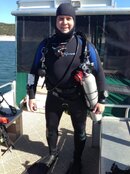masterproscuba
Registered
- Messages
- 5
- Reaction score
- 0
Hello Divers,
I am new to this board and was looking for a way to get some opinions from other divers about a possible solution to a scuba equipment problem. I am interested in mitigating the risk of out-of-air emergency at a low cost without sacrificing the true effectiveness and reliability of the air supply. I simply do recreational scuba diving and am happy in open water. Tech diving and confined space diving is currently outside my skill level so I would not be using the set up for anything but open water diving. I am also not interested in asking about this scenario at a dive shop because dive shop owners are salesmen and are looking to sell equipment like used car salesmen sell old Jeep Wranglers, I already know what opinion I will get at a dive shop.
Normally I would simply purchase a "spare-air" since it is designed for sport divers and does not require extensive training. The issue with this is that owning a "spare-air" or "pony scuba cylinder" will incur additional equipment and maintenance costs for something that will rarely be used. I do not dive enough to justify owning a scuba cylinders but in some instances I have dived in situations where a redundant air supply would be helpful. This situation has arisen when diving with new dive buddies whom I met through dive charters or dive shops. Any time you meet new people there is a level of uncertainty as to their true dependability in emergency situations. Having a redundant air supply would give an additional path to an emergency ascent or sharing of air at depth. The solution to this problem in my mind would simply be to buy a stage rigging system used for Tech side mount rigging and rent an extra scuba cylinder and regulator set and strap it to my belly after I jump in. I believe that a stage rigged cylinder would be the most versatile choice since the only needed equipment to actually purchase would some miscellaneous accessories. This would give me a reliable bailout if both primary air supply and dive buddy failed as opposed to a cold, fatal surprise. Divers any thoughts or experiences with this idea?
I am new to this board and was looking for a way to get some opinions from other divers about a possible solution to a scuba equipment problem. I am interested in mitigating the risk of out-of-air emergency at a low cost without sacrificing the true effectiveness and reliability of the air supply. I simply do recreational scuba diving and am happy in open water. Tech diving and confined space diving is currently outside my skill level so I would not be using the set up for anything but open water diving. I am also not interested in asking about this scenario at a dive shop because dive shop owners are salesmen and are looking to sell equipment like used car salesmen sell old Jeep Wranglers, I already know what opinion I will get at a dive shop.
Normally I would simply purchase a "spare-air" since it is designed for sport divers and does not require extensive training. The issue with this is that owning a "spare-air" or "pony scuba cylinder" will incur additional equipment and maintenance costs for something that will rarely be used. I do not dive enough to justify owning a scuba cylinders but in some instances I have dived in situations where a redundant air supply would be helpful. This situation has arisen when diving with new dive buddies whom I met through dive charters or dive shops. Any time you meet new people there is a level of uncertainty as to their true dependability in emergency situations. Having a redundant air supply would give an additional path to an emergency ascent or sharing of air at depth. The solution to this problem in my mind would simply be to buy a stage rigging system used for Tech side mount rigging and rent an extra scuba cylinder and regulator set and strap it to my belly after I jump in. I believe that a stage rigged cylinder would be the most versatile choice since the only needed equipment to actually purchase would some miscellaneous accessories. This would give me a reliable bailout if both primary air supply and dive buddy failed as opposed to a cold, fatal surprise. Divers any thoughts or experiences with this idea?




